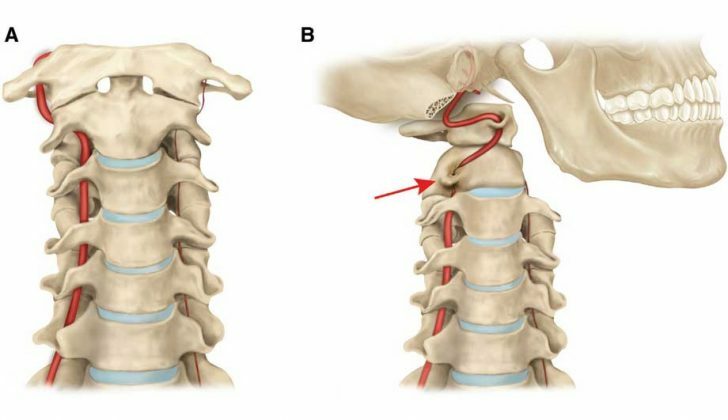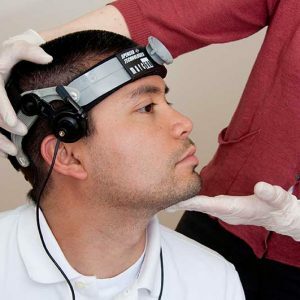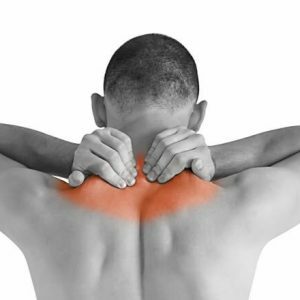Syndrome of the vertebral artery: symptoms and treatment

Syndrome of the vertebral artery( vertebro-basilar syndrome) is a symptom complex that develops when the blood supply to the brain is disturbed.Recently, this ailment has become much "younger";More and more often patients are not only persons of retirement age, but also young people.Pathology is much easier to prevent than cure.
Table of contents: Causes and symptoms of vertebral artery syndrome Diagnosis of vertebral artery syndrome How is the treatment of vertebral artery syndrome treated?Causes and symptoms of vertebral artery syndrome
Immediate cause of the development of the symtomocomplex is the defeat of one or even just two of the main vessels providing blood to the human brain.As a consequence, the central nervous system begins to suffer from a lack of nutrients and hypoxia( oxygen starvation).
 Note: The brain feeds the carotid arteries( through them reaches up to 80% of the blood) and vertebrates passing through the transverse processes of the vertebrae.The most serious disorders( up to the stroke) develop precisely in the pathologies of the carotid arteries.
Note: The brain feeds the carotid arteries( through them reaches up to 80% of the blood) and vertebrates passing through the transverse processes of the vertebrae.The most serious disorders( up to the stroke) develop precisely in the pathologies of the carotid arteries.
The first signs of the beginning problem in most cases are periodic darkening in the eyes and dizziness.If timely not to take adequate measures, i.e., not to start complex treatment, vertebro-basilar syndrome may well become the cause of ischemic stroke.Pathology provokes many other serious diseases, because the brain determines the functional activity of all organs.
Main causes of arterial obstruction:
- spasm or mechanical compression( eg, with osteochondrosis);
- atherosclerotic lesion;
- congenital underdevelopment( hypoplasia).
To so-called.Vertebrogenic reasons for the development of the syndrome include:
- pathologies of degenerative-dystrophic nature( joint arthrosis of the 1st and 2nd vertebrae or atlanto-occipital joint);
- intervertebral hernia;
- osteophytes;
- congenital anomalies of vertebral structure;
- scoliosis or kyphoscoliosis of the cervical region;
- vertebra injury.
Syndrome of the vertebral artery is often the result of compression of the surrounding sympathetic nerve plexus or spasmodic contractions in the muscles of the cervical region.

The lesion of the left vertebral artery is more often diagnosed.It is more susceptible to atherosclerotic lesions due to structural features( direct divergence from the aortic arch).
The syndrome may result from the compression of the vessels by tumor neoplasms or scar tissue after an etching and surgical intervention.
Important: In the presence of one or more predisposing factors, a sudden movement of the head( tilt or turn) is often the trigger for the development of clinical symptoms of the disease.
Signs of vertebral artery syndrome:
- a burning headache in the temporal or parietal region( its intensity increases with running and walking);
- transient reduction in visual acuity;
- pain in the eyes;
- dizziness;
- sharp one-sided hearing impairment( increases and passes spontaneously);
- sensation of tinnitus;
- increased fatigue;
- sensation of pulsation in the head;
- nausea( with a sudden change in head position);
- vomiting that does not relieve;
- angina attacks of stress( cardialgia);
- significant increase in blood pressure( hypertension);
- unstable blood pressure;
- occasionally occurs with a pre-occlusive condition;
- loss of consciousness;
- vertebrae crunch when turning and tilting the head( not always).
Important: pain syndrome can persecute a person permanently or manifest as a periodical seizure.The epicenter of pain is often the occipital region.
Some patients also detect behavioral abnormalities - sudden mood swings, unmotivated anxiety and fear, increased irritability and aggressiveness.
Complications include increased intracranial pressure, paresthesia of the limbs( more often a violation of the sensitivity of the fingers), vegetative-vascular dystonia.
Diagnosis of vertebral artery syndrome
 Diagnosis is based on patient complaints and neurological examination data.In the course of the examination, the stiffness of the muscles of the occipital region, soreness on palpation of the processes of the 1st and 2nd cervical vertebrae are often revealed.As a rule, the patient has difficulty in trying to turn or tilt his head.To confirm the diagnosis, X-ray examination of the cervical spine, ultrasound dopplerography( UZDG) of the vertebral-basilar vessel system and MRI( spine and brain) are mandatory.
Diagnosis is based on patient complaints and neurological examination data.In the course of the examination, the stiffness of the muscles of the occipital region, soreness on palpation of the processes of the 1st and 2nd cervical vertebrae are often revealed.As a rule, the patient has difficulty in trying to turn or tilt his head.To confirm the diagnosis, X-ray examination of the cervical spine, ultrasound dopplerography( UZDG) of the vertebral-basilar vessel system and MRI( spine and brain) are mandatory.
How is the treatment of vertebral artery syndrome treated?
 A comprehensive examination of the patient is performed to determine the severity of the pathology.If his condition is considered satisfactory, therapeutic measures can be performed out-patiently( at home and in a clinic).When certain signs of cerebral ischemia are detected, that is, there is a suspicion of a stroke, urgent placement of the patient in a hospital is necessary.Assistance can be provided in the intensive care unit.
A comprehensive examination of the patient is performed to determine the severity of the pathology.If his condition is considered satisfactory, therapeutic measures can be performed out-patiently( at home and in a clinic).When certain signs of cerebral ischemia are detected, that is, there is a suspicion of a stroke, urgent placement of the patient in a hospital is necessary.Assistance can be provided in the intensive care unit.
Treatment of vertebral artery syndrome must necessarily be complex.
In order to reduce the burden on the cervical area, the patient is individually selected orthopedic corset - the collar of Shanz .The tire should be worn daily for several hours.
Most patients are shown with manual therapy .Procedures should be conducted only by a highly qualified specialist.The task of the doctor-manul is to restore the altered anatomical interrelations of tissues through active exposure.The technique has contraindications, so you must first get a consultation with a neurologist.
 Excellent effect in the treatment of vertebral artery syndrome allows you to achieve general and local professional massage.Especially useful is the effect on the fabric of the collar zone - it stimulates blood circulation, and eliminates spasms and pain.
Excellent effect in the treatment of vertebral artery syndrome allows you to achieve general and local professional massage.Especially useful is the effect on the fabric of the collar zone - it stimulates blood circulation, and eliminates spasms and pain.
To reduce the severity of pain and completely get rid of it, acupuncture will help - the effect on biologically active points.Acupuncture can also cope with concomitant neurologic disorders, including - cardialgia and dizziness.
Pharmacotherapy presupposes a course of administration( introduction) of vitamin complexes, vascular drugs and drugs that help to relieve the patient of dizziness and other vestibular symptoms.
The main groups of drugs for the treatment of vertebral artery syndrome:
- painkillers( Baralgin, Pentalgin);
- non-steroidal anti-inflammatory drugs( Ketorol, Nimesil, Ketoprofen, Movalis);
- means for improving cerebral blood flow( Cinnarizine, Cavinton).
In a number of cases, the cure significantly speeds up the extension of the spine under its own weight on a special couch.This technique is known as autogravitational therapy.
The hardware treatment is also shown.Of the physiotherapeutic procedures, electrophoresis with analgesic drugs, phonophoresis with hydrocortisone, and magnetotherapy and exposure to dynamic currents are most effective.Physiotherapy procedures help to reduce pain and stimulate metabolic processes in tissues.With their help you can stop local inflammation.
Each patient is selected individual complex exercise therapy - therapeutic gymnastics.Dosed physical activity is shown only after relief of ischemic disorders and pain syndrome.
Sometimes, to improve cerebral blood flow, hirudotherapy is prescribed - treatment with leeches.
Early diagnosis and timely initiated adequate therapy allows avoiding serious complications of vertebral artery syndrome and disability.
Self-medication in this case is not only useless, and very dangerous.From the causes that caused the syndrome of the vertebral artery, it is impossible to get rid of using herbs and compresses.Medical tactics largely depends on the age of the patient suffering from pathology, the individual characteristics of his body and the presence of concomitant diseases.
In advanced situations, neurosurgical intervention is required;Certain problems can be eliminated only in an operative way.
Plisov Vladimir, medical reviewer



